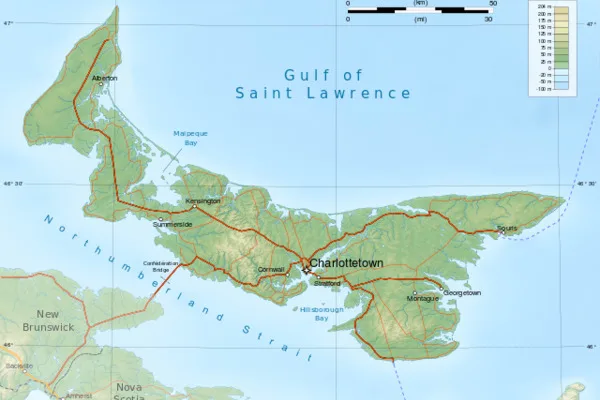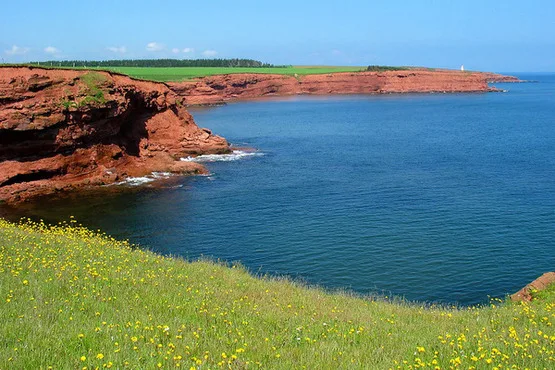Are you seeking adventure, relaxation, or cultural immersion? Whatever your desires, Prince Edward Island offers a plethora of experiences to captivate your senses and ignite your curiosity. From the serene beaches to the charming countryside, every corner of this island holds a story waiting to be discovered.

Author : Flappiefh – wikimedia.org
Glen Valley. 142 metres, 466 feet
| Attribute | Details |
|---|---|
| Altitude | 142 m, 466 f |
| Location | 46° 20′ N, 63° 25′ W |
| NTS Map | 11 L/6 & 11 L/11 North Rustico |
| Calendar | NA |
| Parks | NA |
| Fast Facts | CAPITAL: Charlottetown, PEI PROVINCIAL FLOWER: Lady’s Slipper BIRD: Blue Jay PROVINCIAL TREE: Red Oak |
History
- Settlement Patterns: The island’s relatively low elevation made it attractive to early settlers, particularly European colonizers in the 18th century. The gentle terrain facilitated agriculture and made it easier to establish farms and communities across the island.
- Agriculture: The flat landscape of Prince Edward Island, coupled with its fertile soil, has long been conducive to agriculture. Early settlers quickly recognized the potential for farming, and agriculture became the backbone of the island’s economy. Over the centuries, the island has been known for its potato farming, dairy production, and other agricultural pursuits, which continue to be vital to the island’s economy today.
- Transportation and Infrastructure: The low elevation of Prince Edward Island made it relatively straightforward to develop transportation networks and infrastructure. This accessibility helped foster economic growth and development on the island.
- Local Traditions: The island’s elevation, or rather its lack thereof, has influenced various local traditions and activities. For example, the island’s flat landscape is ideal for cycling, and cycling has become a popular recreational activity for residents and visitors alike. Additionally, the island’s coastline, which is largely accessible due to its low elevation, has inspired traditional industries such as fishing and shellfish harvesting, which remain important parts of the island’s cultural heritage.
- Cultural Identity: Prince Edward Island’s elevation, or rather its flatness, has become a defining characteristic of the island’s cultural identity. The landscape has inspired artists, writers, and musicians who have celebrated its beauty and simplicity in their works.
Climate and Weather
Prince Edward Island’s low elevation significantly influences its climate and weather patterns, creating a unique environment that visitors may find interesting to explore. Here’s how the island’s elevation affects temperature, precipitation, and other weather phenomena:
Temperature
The island’s low elevation contributes to a relatively mild climate, characterized by warm summers and cool winters. The flat terrain allows heat from the sun to be absorbed and retained, leading to higher temperatures compared to inland areas with higher elevations. However, coastal breezes can also moderate temperatures, providing relief during hot summer days and preventing extreme cold in winter.
Precipitation
Prince Edward Island’s low elevation influences precipitation patterns, particularly in relation to rainfall. The island’s flat landscape allows weather systems to move across the region more easily, resulting in fairly consistent rainfall throughout the year. Coastal areas may experience slightly higher precipitation due to proximity to the ocean and the effects of sea breezes.
Wind
The island’s low elevation also affects wind patterns, with coastal areas experiencing stronger winds compared to inland regions. The relatively flat terrain allows winds to flow more freely across the landscape, creating breezy conditions, especially along the coastline. These winds can have both positive and negative impacts, from cooling effect during hot summer days to potential erosion along coastal areas.
Fog
Prince Edward Island’s low elevation, combined with its coastal location, makes it prone to foggy conditions, particularly during certain times of the year. The island’s flat terrain and proximity to the ocean create ideal conditions for the formation of fog, which can sometimes linger for extended periods, especially in the early morning or late evening. While fog can create atmospheric effects and enhance the island’s natural beauty, it can also pose challenges for transportation and outdoor activities.

Author: Peter M Graham – flickr.com
Microclimates
Despite its relatively uniform elevation, Prince Edward Island exhibits microclimates due to variations in topography and proximity to the coast. Sheltered inland areas may experience slightly different weather conditions compared to coastal regions, such as temperature variations or differences in precipitation levels. These microclimates add to the diversity of experiences that visitors can encounter while exploring the island.
In summary, Prince Edward Island’s low elevation influences its climate and weather patterns in various ways, from moderating temperatures and enhancing precipitation to creating unique wind and fog conditions. Understanding these influences can help visitors better prepare for their travels and appreciate the island’s natural environment.
Seasonal Events and Festivals
Not only renowned for its stunning landscapes and rich history, Prince Edward Island also hosts vibrant seasonal events and festivals celebrating its culture, heritage, and natural beauty. Here are some notable events that take place throughout the year:
Cavendish Beach Music Festival
One of the biggest summer events, the Cavendish Beach Music Festival, occurs annually in July. Held on the picturesque shores, this multi-day music festival features performances by top country music artists from Canada and around the world. Visitors can enjoy live music against the backdrop of sandy beaches and rolling waves, making it a quintessential experience.
PEI Fall Flavours Festival
Showcasing the best of local food and drink, events range from culinary competitions and farm-to-table feasts to cooking demonstrations and tastings. Visitors can sample fresh seafood, locally grown produce, and artisanal products while learning about the vibrant food culture.
Tyne Valley Oyster Festival
The Tyne Valley Oyster Festival, held annually in August, pays homage to this culinary treasure with a week-long celebration of all things oyster-related. Visitors can enjoy oyster shucking competitions, seafood feasts, live music, and family-friendly activities, all set against the backdrop of the scenic coastline.
PEI International Shellfish Festival
Another must-visit event for seafood enthusiasts is the PEI International Shellfish Festival, held in Charlottetown each September. This premier culinary event attracts chefs, foodies, and shellfish lovers from around the world to indulge in an array of shellfish dishes, including lobster, mussels, clams, and of course, PEI’s famous oysters. The festival also features live entertainment, cooking competitions, and interactive culinary experiences, making it a feast for the senses.
Old Home Week
Old Home Week is a beloved tradition, dating back over 130 years. Held annually in August in Charlottetown, this multi-day event celebrates the agricultural heritage with livestock shows, harness racing, agricultural exhibits, and carnival rides. Visitors can experience the excitement of the fairgrounds, indulge in classic fair food, and enjoy live entertainment, making it a fun-filled event for the whole family.
Conclusion
Prince Edward Island’s low elevation facilitated early settlement by European colonizers in the 18th century, shaping its history and culture. The island’s flat landscape and fertile soil have long supported agriculture, with potato farming and dairy production being key industries. Transportation networks and infrastructure on the island have flourished due to its low elevation, fostering economic growth and connectivity. Local traditions and activities, such as cycling and fishing, are influenced by the island’s lack of significant elevation changes. The island’s cultural identity is deeply rooted in its flatness, inspiring artists, writers, and musicians, and celebrated in local festivals and culinary traditions. Prince Edward Island’s climate and weather patterns are influenced by its low elevation, resulting in mild temperatures, consistent rainfall, and unique wind and fog conditions. The island hosts a variety of seasonal events and festivals throughout the year, showcasing its culture, heritage, and natural beauty.
FAQs
How does the low elevation influence the climate of Prince Edward Island?
The low elevation contributes to a relatively mild climate, characterized by warm summers and cool winters. The flat terrain allows heat from the sun to be absorbed and retained, leading to higher temperatures compared to inland areas with higher elevations. Coastal breezes also moderate temperatures, providing relief during hot summer days and preventing extreme cold in winter.
What are some key industries supported by the flat landscape?
The flat landscape and fertile soil have long supported agriculture, with potato farming and dairy production being key industries. The gentle terrain facilitated early settlement by European colonizers in the 18th century, shaping the history and culture.
How has the low elevation influenced transportation networks?
The low elevation has made it relatively straightforward to develop transportation networks and infrastructure. Roads, railways, and later highways were constructed with relative ease across the flat terrain, connecting communities and facilitating trade and commerce. This accessibility has fostered economic growth and development.
What are some local traditions and activities influenced by the lack of significant elevation changes?
The flat landscape is ideal for cycling, making it a popular recreational activity. Additionally, the accessible coastline has inspired traditional industries such as fishing and shellfish harvesting, which remain important parts of the cultural heritage.